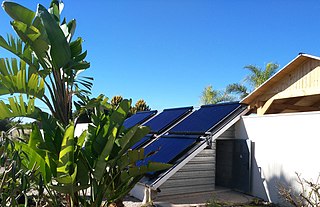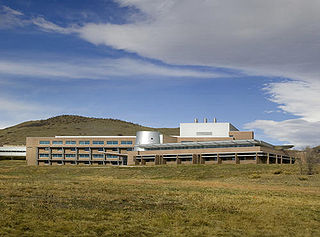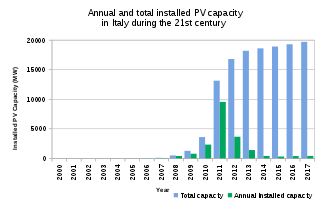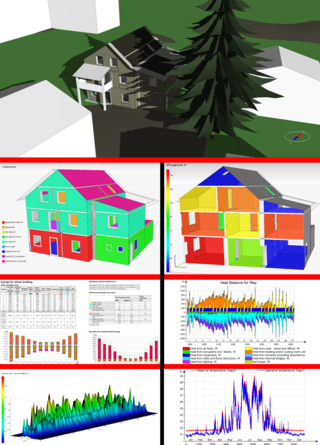Related Research Articles
Distributed generation, also distributed energy, on-site generation (OSG), or district/decentralized energy, is electrical generation and storage performed by a variety of small, grid-connected or distribution system-connected devices referred to as distributed energy resources (DER).

Solar water heating (SWH) is heating water by sunlight, using a solar thermal collector. A variety of configurations are available at varying cost to provide solutions in different climates and latitudes. SWHs are widely used for residential and some industrial applications.

The National Renewable Energy Laboratory (NREL) in the US specializes in the research and development of renewable energy, energy efficiency, energy systems integration, and sustainable transportation. NREL is a federally funded research and development center sponsored by the Department of Energy and operated by the Alliance for Sustainable Energy, a joint venture between MRIGlobal and Battelle. Located in Golden, Colorado, NREL is home to the National Center for Photovoltaics, the National Bioenergy Center, and the National Wind Technology Center.

A Zero-Energy Building (ZEB), also known as a Net Zero-Energy (NZE) building, is a building with net zero energy consumption, meaning the total amount of energy used by the building on an annual basis is equal to the amount of renewable energy created on the site or in other definitions by renewable energy sources offsite, using technology such as heat pumps, high efficiency windows and insulation, and solar panels.

TRNSYS is a simulation program primarily used in the fields of renewable energy engineering and building simulation for passive as well as active solar design. TRNSYS is a commercial software package developed at the University of Wisconsin.

A solar combisystem provides both solar space heating and cooling as well as hot water from a common array of solar thermal collectors, usually backed up by an auxiliary non-solar heat source.

Solar power, also known as solar electricity, is the conversion of energy from sunlight into electricity, either directly using photovoltaics (PV) or indirectly using concentrated solar power. Photovoltaic cells convert light into an electric current using the photovoltaic effect. Concentrated solar power systems use lenses or mirrors and solar tracking systems to focus a large area of sunlight to a hot spot, often to drive a steam turbine.

Solar power includes solar farms as well as local distributed generation, mostly on rooftops and increasingly from community solar arrays. In 2022, utility-scale solar power generated 145.6 terawatt-hours (TWh), or 3.4% of electricity in the United States. Total solar generation that year, including estimated small-scale photovoltaic generation, was 204 TWh.
A photovoltaic system, also called a PV system or solar power system, is an electric power system designed to supply usable solar power by means of photovoltaics. It consists of an arrangement of several components, including solar panels to absorb and convert sunlight into electricity, a solar inverter to convert the output from direct to alternating current, as well as mounting, cabling, and other electrical accessories to set up a working system. It may also use a solar tracking system to improve the system's overall performance and include an integrated battery.
Specialized wind energy software applications aid in the development and operation of wind farms.
Wind resource assessment is the process by which wind power developers estimate the future energy production of a wind farm. Accurate wind resource assessments are crucial to the successful development of wind farms.

Solar air heating is a solar thermal technology in which the energy from the sun, insolation, is captured by an absorbing medium and used to heat air. Solar air heating is a renewable energy heating technology used to heat or condition air for buildings or process heat applications. It is typically the most cost-effective out of all the solar technologies, especially in commercial and industrial applications, and it addresses the largest usage of building energy in heating climates, which is space heating and industrial process heating.

Solar power is an important contributor to electricity generation in Italy, accounting for 8% of the total in 2017. As of 2022, the country has a total installed capacity of 22.56 GW. In 2019, Italy set a national goal of reaching 50 GW by 2030.

Solar power in Connecticut establishes Connecticut as the second state in the US to reach grid parity, after Hawaii, due to the high average cost of electricity. Installing solar panels for a home provides an estimated 15.6% return on investment.

Building performance simulation (BPS) is the replication of aspects of building performance using a computer-based, mathematical model created on the basis of fundamental physical principles and sound engineering practice. The objective of building performance simulation is the quantification of aspects of building performance which are relevant to the design, construction, operation and control of buildings. Building performance simulation has various sub-domains; most prominent are thermal simulation, lighting simulation, acoustical simulation and air flow simulation. Most building performance simulation is based on the use of bespoke simulation software. Building performance simulation itself is a field within the wider realm of scientific computing.
OpenStudio is a suite of free and open-source software applications for building energy analysis used in building information modeling. OpenStudio applications run on Microsoft Windows, Macintosh, and Linux platforms. Its primary application is a plugin for proprietary SketchUp, that enables engineers to view and edit 3D models for EnergyPlus simulation software.
Sensitivity analysis identifies how uncertainties in input parameters affect important measures of building performance, such as cost, indoor thermal comfort, or CO2 emissions. Input parameters for buildings fall into roughly three categories:
Open energy system database projects employ open data methods to collect, clean, and republish energy-related datasets for open use. The resulting information is then available, given a suitable open license, for statistical analysis and for building numerical energy system models, including open energy system models. Permissive licenses like Creative Commons CC0 and CC BY are preferred, but some projects will house data made public under market transparency regulations and carrying unqualified copyright.

IDA IndoorClimate andEnergy is a Building performance simulation (BPS) software. IDA ICE is a simulation application for the multi-zonal and dynamic study of indoor climate phenomena as well as energy use. The implemented models are state of the art, many studies show that simulation results and measured data compare well.

Photovoltaic system performance is a function of the climatic conditions, the equipment used and the system configuration. PV performance can be measured as the ratio of actual solar PV system output vs expected values, the measurement being essential for proper solar PV facility's operation and maintenance. The primary energy input is the global light irradiance in the plane of the solar arrays, and this in turn is a combination of the direct and the diffuse radiation.
References
- 1 2 Wilcox, S. and W. Marion. User's Manual for TMY3 Data Sets, NREL/TP-581-43156. April, 2008. Golden, Colorado: National Renewable Energy Laboratory
- ↑ "climate.onebuilding.org". climate.onebuilding.org.
- ↑ "Design and simulation software for renewable energy | Valentin Software".
- ↑ "SOLARSCHMIEDE Software GmbH | Planung PV AnlagenStartseite". www.solarschmiede.de.
- ↑ "nPro: Design tool for district energy systems with heat networks". www.npro.energy.
- ↑ "PVSyst - Photovoltaic software" . Retrieved 2024-02-07.